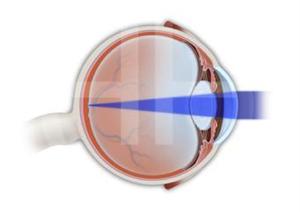ENQUIRY FORM
Myopia, Hyperopia, Astigmatism, Presbyopia
Refractive error is a common vision problem. It occurs when the eye cannot clearly focus images onto the back surface of the eye (i.e the retina). This results in blurring of vision.
Changes in the length of the eyeball (longer or shorter), shape of the cornea or density of the crystalline lens within the eye, or ageing of this lens can cause refractive error. A common type of refractive error seen in Singapore is “myopia”. Refractive error can affect your daily activities and mobility if it is severe and uncorrected.
What are the types of refractive error?
The four common types of refractive error are
1. Myopia (short-sightedness)
2. Hyperopia (long-sightedness)
3. Astigmatism
4. Presbyopia (“lao hua”)
To understand these refractive errors better, it helps to understand:
What happens to light rays when they enter the eye?The light rays from an object enter the eye through the pupils, passing through the crystalline lens which helps to focus these rays onto the retina (the back surface of the eye). The retina then collects this information and sends it to the brain for interpretation. Therefore, if light rays are not well focused onto the retina, images will not be clearly seen. |
 NORMAL EYE |
What is myopia ? (short-sightedness / near-sightedness)Myopia occurs when light rays are focused in front of the retina rather than on the retina. This could be due either to a long eyeball or to too much focusing power of the eye. It causes distant objects to be blurry while near objects remain clear. |
 MYOPIC EYE |
What is hyperopia? (long-sightedness / far-sightedness)Hyperopia occurs when light rays are focused behind the retina rather than on the retina. This could be due either to a small/short eyeball or to too little focusing power of the eye. It causes both near and distance objects to be blurry. |
 HYPEROPIC EYE |
What is astigmatism?Astigmatism occurs when the cornea is more curved in one direction than in the other, resulting in light rays that are focused at several points in front of and/or behind the retina. This leads to a distorted image and is perceived by the patient as a blur image. The curvature differences that cause astigmatism can be easily understood when a normal eye is thought of as a perfectly shaped round basketball whereas an astigmatic eye is irregularly shaped like a rugby ball. Near and distant vision can both be affected. Optical aids can be prescribed for significant astigmatism. |
 ASTIGMATISM |
What is presbyopia ("lao hua")?
Presbyopia is an age-related condition in which the ability of the eye to focus up close becomes progressively more difficult. This is due to hardening of the crystalline lens in the eye and weakening of the focusing muscle. Presbyopia results in difficulty with reading and other near tasks. If you need to hold the newspaper further and further away to read, it could be a sign that you are having early presbyopia. This affects individuals nearing age 40.
Optical aids such as glasses (eg: bifocal or progressive glasses), contact lenses (eg: bifocal contact lenses, monovision correction) can be used to correct presbyopia.
Cataract or clear lens extraction with specially designed, correctly powered intraocular lens implant can correct presbyopia. Learn more about cataract or clear lens extraction.

